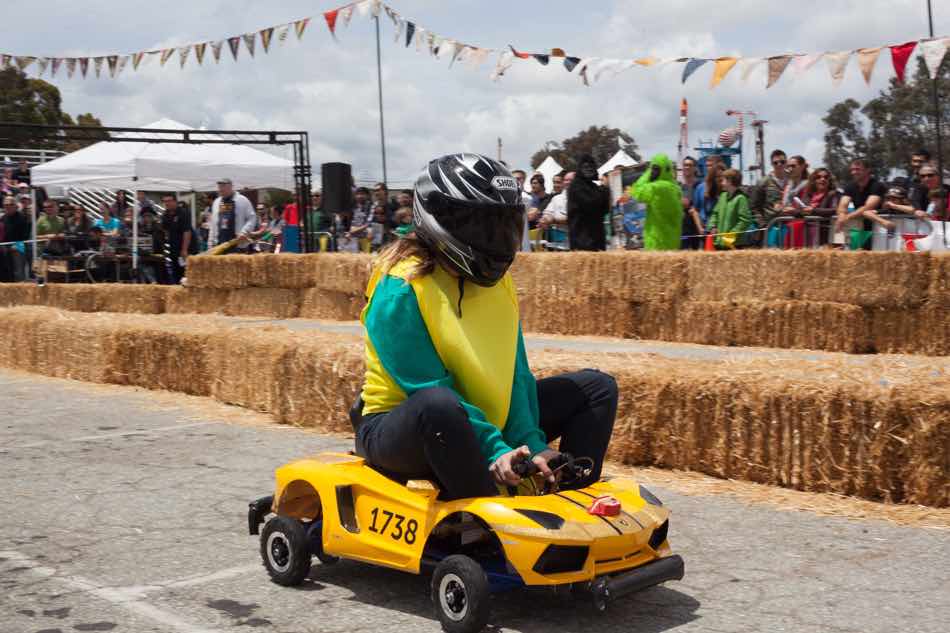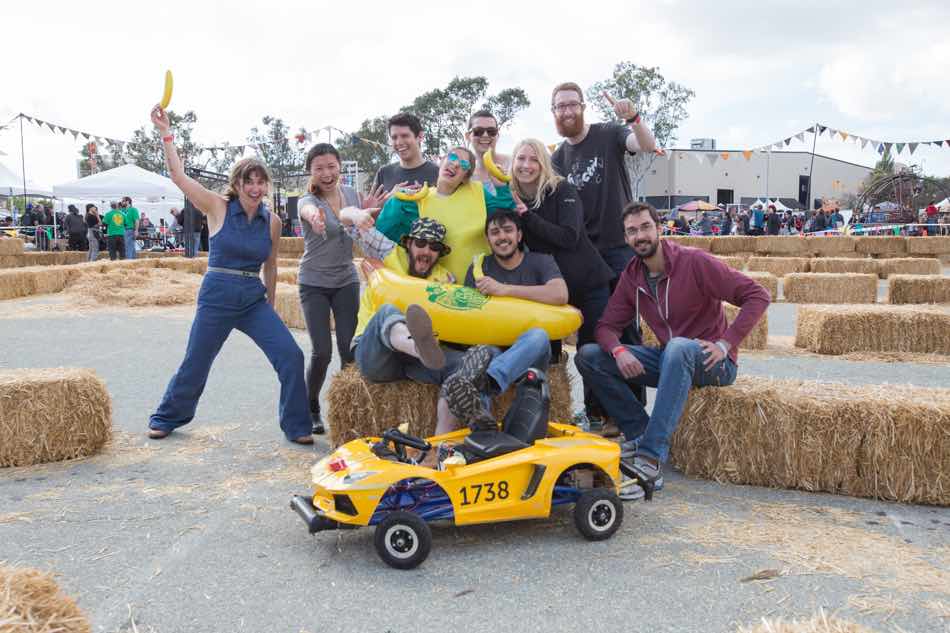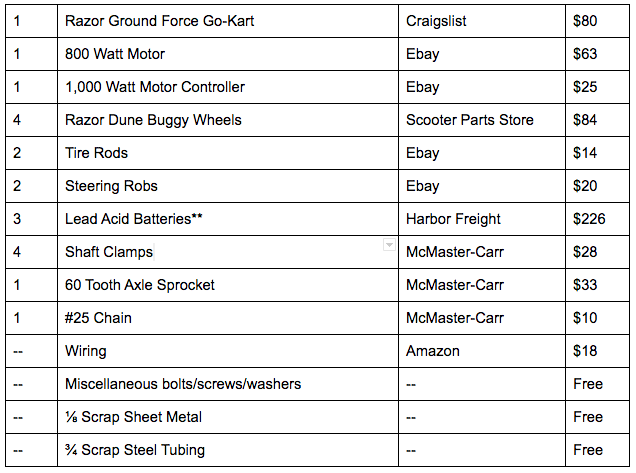Time to read: 5 min
Fictiv spent several weeks collaborating with Mindtribe to build a $500 electric car, using the base of a Power Wheels Lamborghini to race at the Power Racing Series at the 2016 Bay Area Maker Faire.

In Part 2 of our Power Racing Series, we wrapped up the vehicle and took our first practice laps. In this final post, I’ll cover the the last-minute details of our build, the race outcome, a few challenges + insights we discovered, and the final BOM cost.
Here’s some footage of the race itself at Maker Faire, in all its wacky glory:
The Finished Go-Kart

After approximately three weeks of building and a frantic, one-week push to get the car working, we had a running machine. An 800-watt motor and three 12-Volt lead acid batteries powered the 260-lb cart (with driver) to max velocity in a little under eight seconds, at approximately 12 mph. It may not sound like a lot, but when you squeeze into a tiny kart and hit the throttle, wow, does it move!
We were admittedly running tight on time toward the end, so we decided to proceed on the path of least resistance and zip-tie the Lambo body to the frame.
We took a dremel and opened up some of the wheel wells, so the plastic body wasn’t hitting our tires on the turns. Also, we decided to make the power switches more accessible, so we could easily turn the car on and off and preserve battery power during the race.
The “Bananaghini”
After five days of consecutive late-night builds, we were all a bit loopy from lack of sleep, and some of us realized that our Lamborghini car looked a lot like Diddy Kong’s car from Diddy Car Racing. We decided to dress up like Diddy Kong and settled on the name “Bananaghini” for our car.
Since we were all too tired to think logically, we headed to San Mateo early Saturday morning, looking like this:

Race Day 1

We arrived at the Maker Faire around 8am and began setting up our pit area. Changing batteries and drivers and making quick fixes during the race was essential to winning, so we made sure our layout allowed the driver to easily pull in and out of our tent.
Here’s a quick rundown of how we performed on Day 1:
Qualifying lap – 7th place out of 13
The qualifying lap was a two-lap speed test. Our time came in at 19.3 seconds, which was just around the middle of the pack.
For comparison, the fastest time was 14.1 seconds, and the slowest time was 1+ minutes. We weren’t too worried, however, since we knew drivers were going to play a large role in this race, with such a small track and thirteen cars.
45-Lap Race – 5th place out of 13
The 45-lap race was the first real race of the day, and we were positioned according to our performance in the qualifying lap.
We chose Lisette, Fictiv’s visual designer, to drive for this race, since she was the smallest and most fearless.
Lisette drove like a champion! We moved from seventh place to fifth in our first race.
35-Lap Race – 6th place out of 13
The last race of day one was a 35-lap race. Because it was short race, we were less worried about battery capacity and needed someone who knew the course well enough to take advantage of the turns and try to overtake cars on the straightaways.
Angela, engineer extraordinaire from Mindtribe, came through, and we moved up one spot from our original seventh-place qualifying time.
We left Day one of the Maker Faire feeling really great about our performance and walked away with fifth place overall. We were excited for the real test the next day—the 75-minute Enduro race.
Race Day 2

The second day of the race presented the biggest challenge for the competitors. While the short races of day one were challenging and required a game plan to try to squeeze seconds off each lap time, day two was more focused on how we had engineered our car.
Anyone can get a kart running with a motor and battery, but very few can get a kart running at full throttle, in one piece, for 75 minutes, without overheating or burning out a motor.
Result: Endurance race (75 minutes) – 8th place out of 13
In the end, we came in 8th place out of 13, not bad for our first year! Here are some of the challenges we encountered + a few insights for next year:
Challenge #1: Tire Wear & Tear
About halfway into our second fifteen-minute round, we encountered a flat tire. Of all the spare tools and parts we brought, we didn’t anticipate these races would cause such wear on our tires! All of them looked worn and minutes away from tearing.
Half the team removed the wheel completely, removed the tube from the tire, and wrapped the hole with lots of electrical tape.
This was just a quick fix, though, and sadly, the tires went flat again about 5 minutes after getting the car back on the track.
Challenge #2: Engine Overheating
To make matters worse, our engine actually started smoking toward the end.
Our team found a leaf blower and a bag of ice and started blowing cold air over the motor to help bring the temperature down. At this point, if you looked around the track, you were able to quickly tell which teams knew what they were doing. Two teams were completely out of the race because their engines burned out, and about four were in our situation.
3 Major Insights
- We learned how teams used caster and camber in their steering to avoid the need for differential.
- We also asked how some of the better teams dealt with heat dissipation to avoid overheating—the key is to try and get airflow through/around your motor in the design stage.
- We all discussed the different types of batteries teams were using, which varied significantly in weight and capacity. Basically, after the last race, it was just a large open source meeting, where people talked about how they built their karts. Yay, open source!
The Final Results
Moxie Points – 4th place out of 13
Overall – 6th place out of 13
The Power Wheels Racing Series is an amazing build for anyone of any skill level. Some groups were out there completely for fun, built karts that could barely move, and focused solely on moxie points; and there were other karts that had months of engineering, testing, and research put into them.
The great thing about the Racing Series is that you don’t have to have the best engineered car to win. In fact, third place overall went to a car that came near last place in every race, because they were able to win the hearts of the crowd and earn moxie points!

The Makers
Jerry Ryle – Vice President, Mindtribe
Sam Kang – Vice President, Mindtribe
Tim Ruitenbeek – Senior Engineer, Mindtribe
Kyle Tucker – Engineer, Mindtribe
Telind Bench – Engineer, Mindtribe
Angela Chu – Associate Engineer, Mindtribe
Jason Gonzalez – Associate Engineer, Mindtribe
Jackie Liao – Product Designer, Fictiv
Lisette Fall-Conroy – Visual Designer, Fictiv
Andrew Hudak – Prototyping Engineer, Fictiv
Sunny Sahota – Prototyping Engineer, Fictiv
Bill of Materials

** Only half the battery total counts toward the final cost of the car
Total Cost: $488










